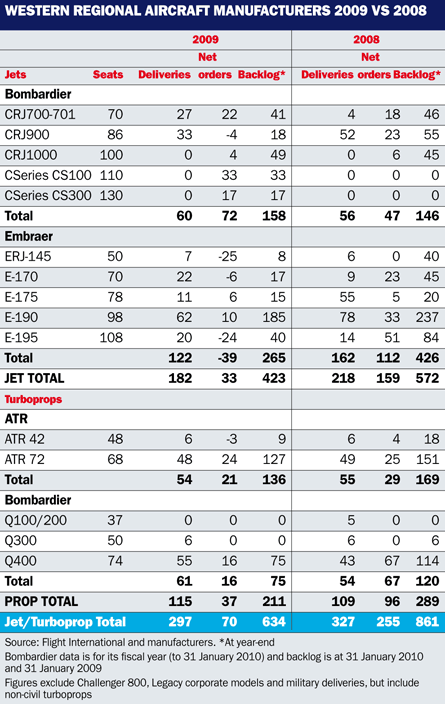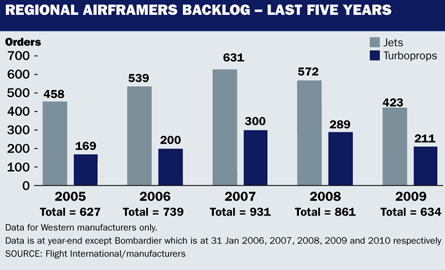The regional aircraft manufacturers will be hoping that 2009 was the perigee of the current slump, having suffered a collapse in demand for their in-production airliners. Output also declined last year, as the slight rise in turboprop shipments was more than offset by a significant fall-off in jet deliveries.
Overall, the regional airframers saw net orders fall almost three-quarters to 70 aircraft last year, from 255 in 2008. The jet sector, which accumulated just 33 net orders compared with 159 the year before, was stymied by cancellations that dragged down net orders in a year when new sales were already slow.
Although the fortunes of turboprops were similarly distressed, with orders dropping 60%, the propeller-driven types won the bragging rights with 37 sales - five more than the jets.
TOP SELLER
Bombardier ended the year as top seller in the sector with 88 net orders (all data is for the Canadian airframer's 2009-10 fiscal year, ending on 31 January), although the bulk came from the 50 launch orders sales for the CSeries twinjet, which straddles the regional and mainline sectors.
 |
|---|
A late rally saw the CRJ racking up 22 net orders, while the Q400 turboprop failed to repeat its strong performance in 2008, with net orders falling from 61 to 17. Despite the boost from the CSeries, Bombardier's order total was down by one-fifth on 2008.
Embraer's overall tally suffered as it lost existing orders for 25 ERJ-145s from China and 30 E-195s - 10 from defunct Italian carrier Alpi Eagles and 20 from Brazil's bankrupt regional BRA. This put the 2009 net orders for these two models seriously into deficit, on minus 25 and 24, respectively.
Although the E-190 garnered 10 net orders, cancellations for the E-170 exactly offset new orders for that model and its bigger sister the E-175, meaning that the combined E-Jet family ended the year down a net 14 orders. So Embraer's full-year net tally was a disappointing minus 39 orders.
ATR pulled out all the stops in 2009 to hit its target of reaching a total of 1,000 orders for its ATR 42/72 programme - a milestone it had originally aimed to reach the year before. The airframer claimed 40 new orders during 2009, but suffered 19 cancellations, which dropped its net tally to 21, down slightly on the year before.
The EADS/Alenia joint venture has benefited from strong demand from South-East Asia, says chief executive Stéphane Mayer: "Around 50% of orders have been coming from the region, so around half our deliveries in the near term will be to airlines in South-East Asia."
 |
|---|
The regional airframers are generally united in the view that they face at least another 12-24 months of slow sales before the market begins a strong recovery, and Richard Aboulafia, vice-president analysis at US analysts Teal Group, concurs. "The US majors are still focused on shedding capacity and rationalising their route networks, and the regional airlines have taken a blow. I don't think they'll recover in 2010," Aboulafia says.
CHINA 'OVERRATED'
"Markets elsewhere have not taken up the slack. China in particular has been highly overrated as a potential source of regional demand," adds Aboulafia. "While larger airplanes such as the E-190/195 have their attractions for mainline carriers, this is a limited niche owing to relatively high seat-mile costs."
ATR and Bombardier are waiting patiently for the US turboprop market to properly wake up, but Aboulafia thinks the chances of any early recovery is being "squeezed out by weak traffic and chronic overcapacity".
Although combined regional deliveries fell almost 10%, the jet and turboprop markets witnessed entirely different fortunes. Bombardier and Embraer both slashed jet production, which saw combined CRJ and E-Jet deliveries fall 18% to 175 aircraft (plus seven Chinese-built ERJ-145s). However, turboprop production increased 11% to 121 units as ATR's output stabilised, while Q Series deliveries rose slightly.
Helped by its strategy of having a foot in both camps, Bombardier's combined airliner deliveries increased by 5% in 2009 to 115 units, making it a match for its Brazilian rival in output with the two companies each delivering 41% of all Western regional aircraft in 2009.
This comes after several years of market share dominance by Embraer - for example in 2008, it had a 50% market share against Bombardier's 34%.
But with the Canadian airframer suffering a dearth of orders in 2009 (and further delays to the start of CRJ1000 deliveries), it has warned that shipments will fall around 20% during its FY2010-11 - jet production will be cut back while Q400 output should be flat.
 |
|---|
Fellow turboprop builder ATR - having been pleasantly surprised at its ability to keep production stable in 2009 in the wake of the global economic turmoil of the last 18 months - says it aims to repeat the trick this year.
Bombardier is now looking to build on the early sales success of the CSeries twinjet, which is sized in the 110- to 145-seat sector, taking its focus away from traditional rivals and into the shark-infested waters of Airbus and Boeing.
"I continue to regard the CSeries as a potential mainline player, but the entire market remains focused on Airbus and Boeing's re-engining plans this year," says Aboulafia. "Given weak traffic in Europe and the USA, there's absolutely no urgency to make a decision on next-generation equipment. Markets that have seen an increase in traffic, particularly China, generally favour larger airplanes, which is another reason for Bombardier to consider a 150-seat CSeries 'stretch' model."
The collapse in orders has resulted in the backlog falling by a quarter to 634 aircraft, although the split remains the two-thirds in favour of jets. Bombardier's CSeries success, combined with Embraer's poor showing last year, has closed up the market shares, with the former rising from 31% to 37% while the latter has dropped from 49% to 42%.
Source: Flight International



















